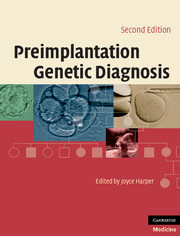Book contents
- Preimplantation Genetic Diagnosis
- Preimplantation Genetic Diagnosis
- Copyright page
- Contents
- Contributors
- Preface
- Section 1 Background
- Section 2 Procedures used in preimplantation genetic diagnosis
- Chapter 8 Clinical aspects of preimplantation genetic diagnosis
- Chapter 9 Polar body biopsy
- Chapter 10 Cleavage-stage embryo biopsy
- Chapter 11 Blastocyst biopsy
- Chapter 12 Preimplantation genetic diagnosis for chromosome rearrangements
- Chapter 13 Preimplantation genetic diagnosis for infertility (preimplantation genetic screening)
- Chapter 14 Preimplantation genetic diagnosis for sex-linked diseases and sex selection for non-medical reasons
- Chapter 15 Preimplantation genetic diagnosis for monogenic disorders: multiplex PCR and whole-genome amplification for gene analysis at the single cell level
- Chapter 16 Quality control and quality assurance in preimplantation genetic diagnosis
- Section 3 Ethics and the future
- Index
Chapter 13 - Preimplantation genetic diagnosis for infertility (preimplantation genetic screening)
from Section 2 - Procedures used in preimplantation genetic diagnosis
Published online by Cambridge University Press: 09 November 2009
- Preimplantation Genetic Diagnosis
- Preimplantation Genetic Diagnosis
- Copyright page
- Contents
- Contributors
- Preface
- Section 1 Background
- Section 2 Procedures used in preimplantation genetic diagnosis
- Chapter 8 Clinical aspects of preimplantation genetic diagnosis
- Chapter 9 Polar body biopsy
- Chapter 10 Cleavage-stage embryo biopsy
- Chapter 11 Blastocyst biopsy
- Chapter 12 Preimplantation genetic diagnosis for chromosome rearrangements
- Chapter 13 Preimplantation genetic diagnosis for infertility (preimplantation genetic screening)
- Chapter 14 Preimplantation genetic diagnosis for sex-linked diseases and sex selection for non-medical reasons
- Chapter 15 Preimplantation genetic diagnosis for monogenic disorders: multiplex PCR and whole-genome amplification for gene analysis at the single cell level
- Chapter 16 Quality control and quality assurance in preimplantation genetic diagnosis
- Section 3 Ethics and the future
- Index
Summary
- Type
- Chapter
- Information
- Preimplantation Genetic Diagnosis , pp. 203 - 229Publisher: Cambridge University PressPrint publication year: 2009
- 1
- Cited by



